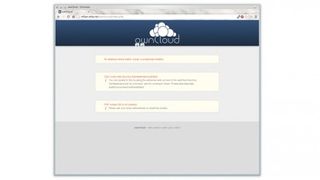Data privacy: how safe is your data in the cloud?
If you want to retain total control over your data, we've got you covered
They could also be made available from the outside, but then you run into the question of the upload speed of your Internet connection. Most domestic Internet connections are asymmetric, giving far higher speeds from downloads than uploads. But accessing data from the outside world counts as an upload, so it would be slower - not unusably so, but it's something to be aware of, particularly if you want to support multiple users.
If you are providing access from the world at large, life is a lot easier if your internet provider is able to give you a static IP address, otherwise you will have to a dynamic DNS service. An alternative is a VPS, a Virtual Private Server.
This is basically a Linux distribution running on a virtual machine at a data centre, so you get the benefit of the fast speeds such environments provide, but it is still your own system and you control what software you include, and any passwords and encryption keys used, and the provider need not be able to read any of your data.You could also use a web host for this, as everything runs on a LAMP stack, but that reduces the options for protecting your data.
Whatever the hardware you choose, real or virtual, you need a full LAMP installation. If you are devoting a box to the job, it is simplest to install on the server-oriented distros, like Ubuntu Server, or something like Debian and select the web server option when installing it.
If you are using an existing system, installing Apache, MySQL and PHP should be sufficient. If you install the software we discuss from your distro's package manager, it will take care of this for you.
ownCloud
Keep your data secure - setup and run your own cloud server

Enough of the reasons why you may want to set up your own cloud service (or not), how do you go about it?
Get daily insight, inspiration and deals in your inbox
Get the hottest deals available in your inbox plus news, reviews, opinion, analysis and more from the TechRadar team.
'The cloud' is a pretty vague term, covering just about any service that allows you to store your data 'out there' accessible via the internet. There are email services like Gmail, file storage services like Dropbox, photo galleries like Flickr, and the list goes on. You may not want to move all of these to a private cloud, the social sharing side of sites like Flickr makes the public aspect of them a benefit - especially as it offers a free 1TB of space now - but that's not always the case.

So where do we start, which service should we privatise first? One project that covers more than one of these areas is ownCloud. While it's main focus is for data storage, along the lines of Dropbox, it also provides a number of other features, some built in and some via plugins. If you want to play around with ownCloud before committing to installing it, try the demo at http://demo.owncloud.org.
This is a web application, so first you need to make sure your web server is working. If your computer has a desktop, you only need to check that http://localhost works in a browser. If you are installing on a separate server, use its hostname instead of localhost.

The latest version of ownCloud is 5.0.6. There are three ways to install ownCloud. If it is in your distro's repositories, install it from your package manager. Alternatively, download the latest tarball from http://owncloud.org/install/ and unpack it into your web root. This is the directory set as DocumentRoot in your Apache configuration. It's usually something like /var/www/ or /var/www/htdocs, although some distros use /srv/www instead of /var/www.
Most Popular

